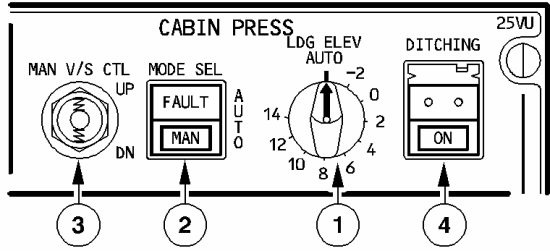Pressurisation control is provided by an outflow valve and two safety valves, one to prevent over-pressurisation (>8.6 psi), the other to prevent under-pressurisation (>1 psi below ambient).
Two identical cabin pressure controllers, one acting as master, the other as a reserve, provide automated control of pressurisation. Each controller has an associated motor with which to modulate the outflow valve. A third motor provides for manual control. The pressure controllers exchange roles 70 seconds after each landing.
The LDG ELEV selector (Figure 4, “Pressurisation controls” (1)) can be set to AUTO or to an altitude. In AUTO the controller uses the landing elevation from the FMGC. If using a manually selected landing elevation, the CAB ALT on the ECAM PRESS page should be used rather than the coarse scale.
The landing QNH is usually sourced from the FMGC. If this is not available, the captain's baro reference from the ADIRS is used.
The automatic pressurisation control operates in 6 modes:
- Ground(GN)
Before takeoff and 55 seconds after landing, the outflow valve is fully opened. At touchdown any residual cabin pressure is released at a cabin vertical speed of 500 fpm.
- Takeoff(TO)
The aircraft is pre-pressurised to 0.1 psi diff at a rate of 400 fpm.
- Climb(CL)
Cabin altitude if a function of actual rate of climb.
- Cruise(CR)
The higher of cabin altitude at level-off or landing field elevation is maintained.
- Descent(DE)
Cabin rate of descent maintained so that cabin pressure equals landing field pressure, with a maximum R.O.D. of 750fpm.
- Abort(AB)
Cabin pressure set to take-off altitude + 0.1 psi.
If a single pressure controller fails, the other automatically takes over. If both pressure controllers fail, an amber FAULT light appears on the MODE SEL push button (Figure 4, “Pressurisation controls” (2)). Pressing this button puts the pressurisation in manual mode, and the spring loaded MAN V/S CTL toggle switch (Figure 4, “Pressurisation controls” (3)) must be used to control the pressurisation. When in MAN mode, the CAB V/S display on the ECAM CRUISE page changes to a gauge format to assist with manual control. Changing to manual mode for 10 seconds and then back to auto mode will cause the pressure controllers to swap roles.
The outflow valve is below the ditching water line. Pressing the ditching button (Figure 4, “Pressurisation controls” (4)) closes the outflow valve unless it is under manual control. Note that use of the ditching button and low pressure ground air will cause a build up of differential pressure.
